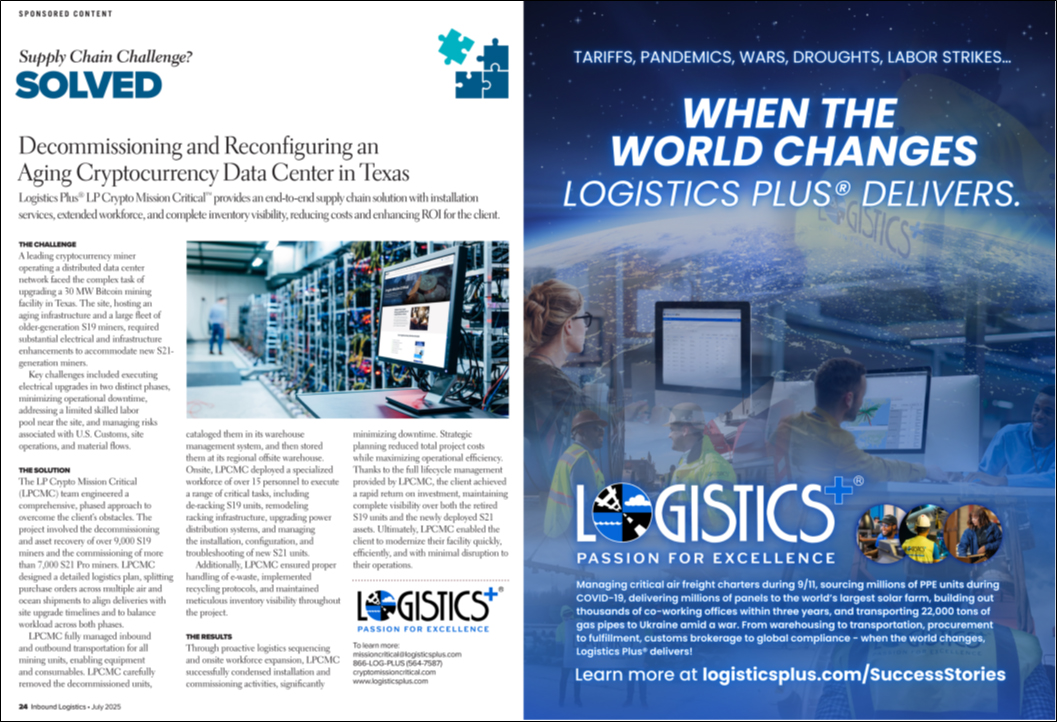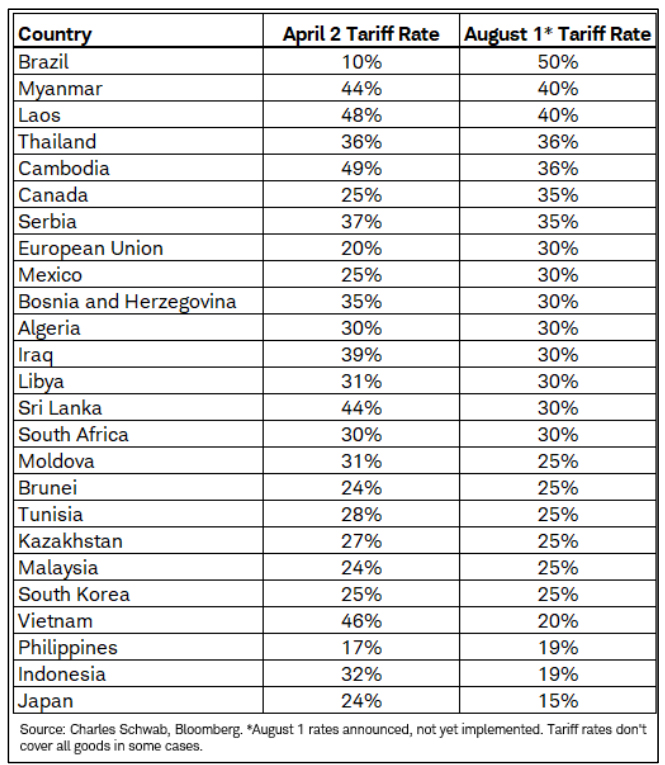
by Scott Frederick | Aug 7, 2025 | News

Logistics Plus Named Exclusive Logistics Provider of the Joe Moore Award
As its logistics sponsor, Logistics Plus will support, transport, and deliver the massive Joe Moore Award trophy.
 ERIE, PA (August 7, 2025) – Logistics Plus, Inc. (LP), a global leader in transportation, logistics, and unique supply chain solutions, is proud to announce it has been named the Exclusive Logistics Provider of the Joe Moore Award, an honor bestowed annually to the most outstanding offensive line unit in college football. The Joe Moore Award media team made the official announcement earlier this week.
ERIE, PA (August 7, 2025) – Logistics Plus, Inc. (LP), a global leader in transportation, logistics, and unique supply chain solutions, is proud to announce it has been named the Exclusive Logistics Provider of the Joe Moore Award, an honor bestowed annually to the most outstanding offensive line unit in college football. The Joe Moore Award media team made the official announcement earlier this week.
This unique sponsorship underscores the vital role that logistics plays not only in industry but also in sports. As part of the partnership, Logistics Plus will support, transport, and deliver the massive 800-pound, seven-foot-tall Joe Moore Award trophy each year to its deserving team, bringing “the trenches” to life in a way that only a logistics company can.
“Offensive lines know a thing or two about working together as a unit to move objects against their will, and that’s why the team at Logistics Plus was such a natural fit for us as a partner,” said Aaron Taylor, co-founder of the Joe Moore Award, a two-time All-American at Notre Dame and current CBS Sports college football analyst. “They’re the best in the business at what they do, and we’re not only excited for them to bring their expertise to bear as we move the biggest award in sports from one place to another, but also to have them collaborate with us as we embark on the second decade of the Joe Moore Award. There are countless parallels in what we honor and what they do – the importance of teamwork, the sacrifice of self, and a commitment to find ways to get the job done – and I’m excited to have them on our team.”
The Joe Moore Award is unique in college football for being the only major award to honor a whole unit rather than an individual player. With a trophy that weighs nearly 800 pounds, is six feet wide, and spans more than seven feet high, delivering it each year is no small feat. That’s where Logistics Plus steps in with the strength, reach, and creativity to get it done. The award currently resides at the U.S. Military Academy at West Point, NY, where the offensive line for the Army Black Knights was recognized with the 2024 honors. In addition to Army, past recipients of the Joe Moore Award include the offensive lines of Alabama (2015, 2020), Iowa (2016), Notre Dame (2017), Oklahoma (2018), LSU (2019), Michigan (2021, 2022), and Washington (2023).
“We’re passionate about teamwork, grit, and delivering results. Those are values that align perfectly with what the Joe Moore Award stands for,” said Jim Berlin, Founder & CEO for Logistics Plus. “It’s an honor to be part of something that celebrates the unsung heroes of the game—the offensive linemen—and we’re excited to be the engine behind the scenes, helping move this award across the country. Some of these young men may be relatively unknown, and many people may not have heard of Logistics Plus. But the best always know the best.”
As part of the sponsorship, Logistics Plus and the Joe Moore Award will collaborate on stories and events that celebrate hard work, unity, and perseverance—core traits of championship teams and world-class logistics providers alike.
To learn more about Logistics Plus and the Joe Moore Award, visit logisticsplus.com/joe-moore-award.
Joe Moore Award Credo
Teamwork. It’s what defines football as a sport, and it is displayed in its greatest glory – in its most profound necessity – in the play of the offensive line. For it is there that individual achievement only matters if the entire unit is performing. When we execute together, great things happen. But if one player missteps, the rest of the team pays the price. That idea – along with hard work and the willingness to strive to be your best – embodies what Coach Joe Moore instilled in his players.
But it’s more than football. It’s about how we live our lives, how we contribute to society, how we participate in the realization of great things. Teamwork is a bond. It’s a promise. And it’s a commitment to put the greater good above ourselves. It’s the greatest form of individual achievement because it requires total sacrifice – of focus, of effort, of ego. The road to success requires an unwavering commitment to purpose that creates an unbreakable bond between each of us. And it makes that success one of the greatest achievements on the planet.
About the Joe Moore Award
The Joe Moore Award is named after Joe Moore, widely regarded as one of the best offensive line coaches in college football history, most notably for his work at Notre Dame and the University of Pittsburgh. Coach Moore sent 52 players on to the NFL, including Bill Fralic, Mark May, Russ Grimm, Jimbo Covert, Andy Heck and others. The Joe Moore Award trophy, crafted by legendary sports sculptor Jerry McKenna, is the largest trophy in college football, standing at a height of seven feet and weighing in at more than 800 pounds. The perpetual trophy is made available for display by the winning university until the conclusion of the following college football season.
About The Foundation for Teamwork
The Foundation for Teamwork is a 501(c)(3) organization dedicated to fostering teamwork in all societal endeavors and bringing that spirit of collective achievement to athletics, education, and organizations.

A photograph of the iconic 800-pound Joe Moore Award.
Learn More or Follow the Joe Moore Award
Find out more at joemooreaward.com and follow the Joe Moore Award on X (@joemooreaward), Instagram (@joemooreaward), and Facebook (facebook.com/JoeMooreAward). For media inquiries, please contact Johnathan McGinty at johnathan@trestlecollective.com.
About Logistics Plus, Inc.
Logistics Plus, Inc. (LP) is a 21st Century Logistics Company™ and a leading worldwide provider of transportation, warehousing, fulfillment, global logistics, business intelligence, technology, and unique supply chain solutions. When the world changes, Logistics Plus® delivers. Founded in 1996, today LP has annual global sales of over $600 million with more than 1,200 employees located in over 50 countries worldwide. LP is recognized as one of the fastest-growing privately-owned logistics companies, a top 3PL provider, a top 100 logistics company, a top freight brokerage and warehousing provider, and a great place to work. With a Passion For Excellence™, its employees put the PLUS in LOGISTICS by doing the big things properly, plus the countless little things that together ensure complete customer satisfaction and success. Learn more at logisticsplus.com or download our media & press kit.




by Scott Frederick | Aug 4, 2025 | News

Logistics Plus Selected as a Top 100 3PL Provider by Inbound Logistics for a Fourth Year
The annual lists recognized the top third-party logistics providers deemed the best of the best by Inbound Logistics editors.
 ERIE, PA (August 4, 2025) – Logistics Plus, Inc. (LP), a global leader in transportation, logistics, and unique supply chain solutions, is proud to announce that it has been selected as a 2025 Top 100 3PL Provider by Inbound Logistics, a leading supply chain and logistics industry publication. It’s the fourth consecutive year that Logistics Plus has been named to the list. The Top 100 list appears in the July 2025 edition of Inbound Logistics and across all content platforms, including magazine, digital, web, and app.
ERIE, PA (August 4, 2025) – Logistics Plus, Inc. (LP), a global leader in transportation, logistics, and unique supply chain solutions, is proud to announce that it has been selected as a 2025 Top 100 3PL Provider by Inbound Logistics, a leading supply chain and logistics industry publication. It’s the fourth consecutive year that Logistics Plus has been named to the list. The Top 100 list appears in the July 2025 edition of Inbound Logistics and across all content platforms, including magazine, digital, web, and app.
“Every great band needs a solid drummer—the one who sets the tempo, drives the energy, and keeps everyone in sync. In the supply chain, that’s exactly what top-performing 3PLs do. You keep the supply chain on beat, responsive, and ready to adapt,” said Felicia Stratten, Editor, Inbound Logistics. “That’s why Logistics Plus has been selected as an Inbound Logistics Top 100 Third-Party Logistics Provider for 2025.”
View the Logistics Plus profile in the digital edition at https://magazine.inboundlogistics.com/view/573415431/.
Earlier this year, Logistics Plus was named to the Transport Topics Top 100 Logistics Companies list.
A Logistics Plus case study and advertisement are also showcased in the magazine.

About Inbound Logistics
Inbound Logistics (IL) is the pioneering magazine empowering demand-driven enterprises. IL’s educational mission is to guide businesses to efficiently manage logistics, reduce and speed inventory, and neutralize transportation cost increases by aligning supply to demand and adjusting enterprise functions to support that paradigm shift. More information about demand-driven enterprise practices is available at inboundlogistics.com.
About Logistics Plus, Inc.
Logistics Plus, Inc. (LP) is a 21st Century Logistics Company™ and a leading worldwide provider of transportation, warehousing, fulfillment, global logistics, business intelligence, technology, and unique supply chain solutions. When the world changes, Logistics Plus® delivers. Founded in 1996, today LP has annual global sales of over $600M with more than 1,200 employees located in 50+ countries worldwide. LP is recognized as one of the fastest-growing privately-owned logistics companies, a top 3PL provider, a top 100 logistics company, a top freight brokerage and warehousing provider, and a great place to work. With a Passion For Excellence™, its employees put the PLUS in LOGISTICS by doing the big things properly, plus the countless little things that together ensure complete customer satisfaction and success. Learn more at logisticsplus.com or download our media & press kit.




by Scott Frederick | Jul 24, 2025 | Global Logistics Alerts

 Negotiated deal announcements like the reported Japan and Indonesia agreements could start coming much faster. Some are firm, some are handshakes, and there is a lot of confusion. But there are a couple of sources out there that are keeping a good tab on the tariffs themselves.
Negotiated deal announcements like the reported Japan and Indonesia agreements could start coming much faster. Some are firm, some are handshakes, and there is a lot of confusion. But there are a couple of sources out there that are keeping a good tab on the tariffs themselves.
The broader country-based tariff list at right shows the current tariff (if a deal is in place) and the threat for August 1st if a deal is not in place.
I won’t speculate any longer on which deals are close, and which aren’t. In this case, you can’t predict the unpredictable.
Versus the pre-Trump period, here are the transitions coming out of the current trade deals.
Japan: 2% to 15%
Indonesia: 3% to 19%
Philippines: 3% to 19%
Vietnam: 3% to 20%
If all of these tariffs stick, and there is no diversion of trade because of the tariff rate (some of these trading partners may see a shifting of sourcing from China to one of these alternative markets if the final tariff rate for China comes in higher than expected), it is expected to generate a net income difference of ~$49.4 billion annually over prior rates.
As other deals are struck, our eyes will be primarily on the larger markets like China, the EU, Canada, Mexico, Brazil, South Korea, and perhaps Thailand, Malaysia and a few others.
Again, we know historically that higher tariffs can lead to some sourcing shifts – and some of the industrial capacity buildout in the US will eat some of this market share. – KP


by Scott Frederick | Jul 8, 2025 | Global Logistics Alerts

Updated Guidance
Extension of Pause
- The 90‑day suspension of country‑specific “reciprocal” tariffs—originally set to expire July 9—has been extended by executive order until August 1, 2025, providing additional time for trade negotiations.
Continued Universal 10% Duty
- The baseline 10% tariff remains in force on most imported goods (excluding China, Hong Kong, Macau, and select exempt categories), stacking on top of existing duties.
China Tariffs Remain High
- Imports from China, Hong Kong, and Macau are still subject to a steep 125% “reciprocal” duty, cumulative with other applicable tariffs.
Letters Issued to Trading Partners
- Formal notifications have been dispatched to trading countries—particularly those with significant trade imbalances—detailing their specific proposed tariff rates meant to mirror duties imposed on U.S. exports.
Tariff Stacking Continues
- Duties from this program are additive: the 10% universal rate applies in tandem with existing Section 232 sector tariffs and standard import duties.
Strategic Window Ahead
With the pause now running through August 1, logistics and trade teams should:
- Track outcomes of bilateral talks and rate changes.
- Analyze ongoing cost stacking on affected cargoes.
- Plan for potential customs recalibrations starting August
Logistics‑Ready Actions
- Check supplier invoices and landed cost projections for new duties and adjust quotes accordingly.
- Update compliance checklists, HS codes, and duty rate tables.
- Communicate with U.S. customs brokers and partners about possible tariff rate changes post-August












 Negotiated deal announcements like the reported Japan and Indonesia agreements could start coming much faster. Some are firm, some are handshakes, and there is a lot of confusion. But there are a couple of sources out there that are keeping a good tab on the tariffs themselves.
Negotiated deal announcements like the reported Japan and Indonesia agreements could start coming much faster. Some are firm, some are handshakes, and there is a lot of confusion. But there are a couple of sources out there that are keeping a good tab on the tariffs themselves.